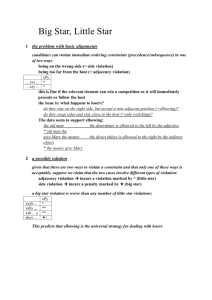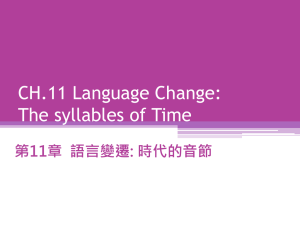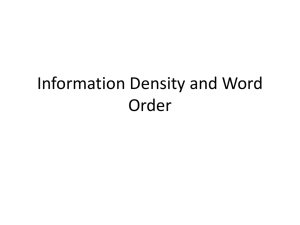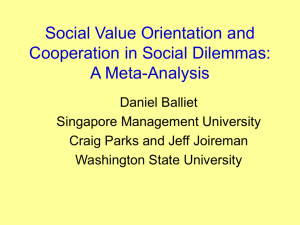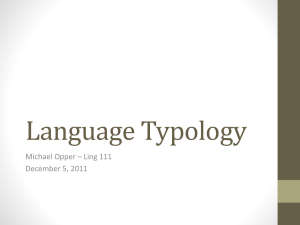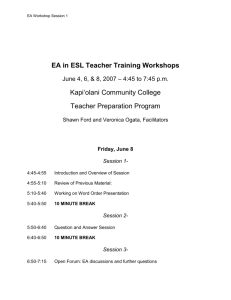Chapter 9 - Arizona State University
advertisement
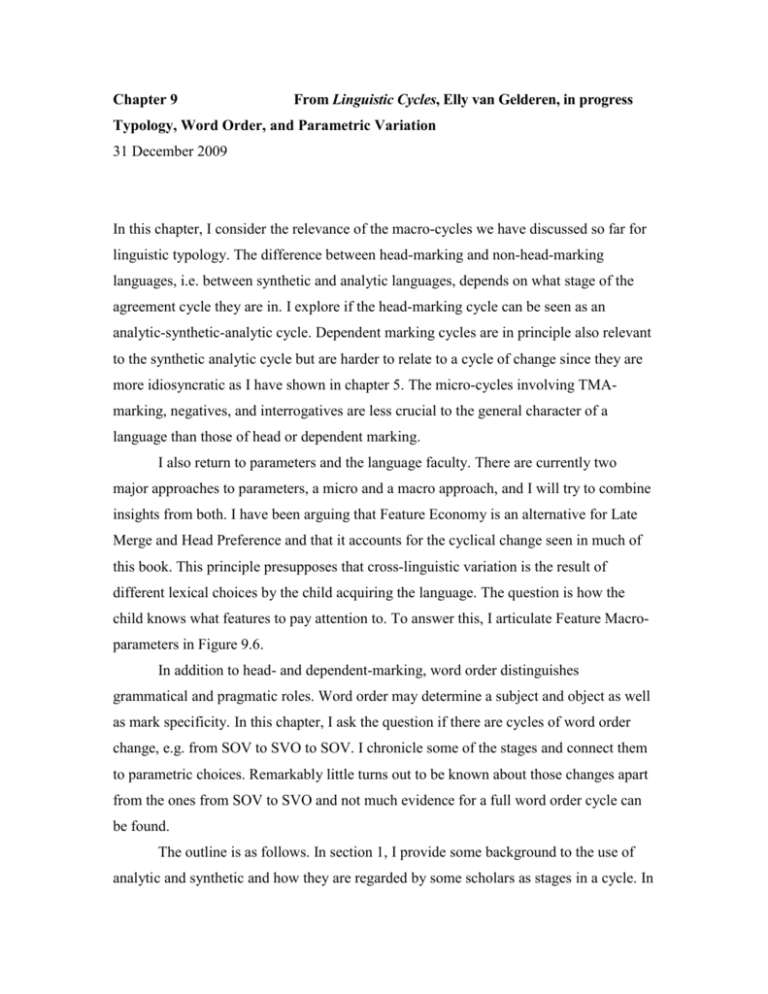
Chapter 9 From Linguistic Cycles, Elly van Gelderen, in progress Typology, Word Order, and Parametric Variation 31 December 2009 In this chapter, I consider the relevance of the macro-cycles we have discussed so far for linguistic typology. The difference between head-marking and non-head-marking languages, i.e. between synthetic and analytic languages, depends on what stage of the agreement cycle they are in. I explore if the head-marking cycle can be seen as an analytic-synthetic-analytic cycle. Dependent marking cycles are in principle also relevant to the synthetic analytic cycle but are harder to relate to a cycle of change since they are more idiosyncratic as I have shown in chapter 5. The micro-cycles involving TMAmarking, negatives, and interrogatives are less crucial to the general character of a language than those of head or dependent marking. I also return to parameters and the language faculty. There are currently two major approaches to parameters, a micro and a macro approach, and I will try to combine insights from both. I have been arguing that Feature Economy is an alternative for Late Merge and Head Preference and that it accounts for the cyclical change seen in much of this book. This principle presupposes that cross-linguistic variation is the result of different lexical choices by the child acquiring the language. The question is how the child knows what features to pay attention to. To answer this, I articulate Feature Macroparameters in Figure 9.6. In addition to head- and dependent-marking, word order distinguishes grammatical and pragmatic roles. Word order may determine a subject and object as well as mark specificity. In this chapter, I ask the question if there are cycles of word order change, e.g. from SOV to SVO to SOV. I chronicle some of the stages and connect them to parametric choices. Remarkably little turns out to be known about those changes apart from the ones from SOV to SVO and not much evidence for a full word order cycle can be found. The outline is as follows. In section 1, I provide some background to the use of analytic and synthetic and how they are regarded by some scholars as stages in a cycle. In section 2, I review how the cycles discussed in chapters 2 to 8 fit into the discussion on stages in an analytic-synthetic cycle. Looking at cycles in terms of Minimalist features brings up many questions on the nature of features. This section therefore includes a plea to revisit the characteristics of features in a more systematic way. In section 3, I discuss parameters and provide two different views on parameters, feature-based (as in Chomsky 1995 and others) and non-feature-based (as in Baker 2001; 2008a). I argue that a featurebased approach best represents the cyclical changes, but present the choices language learners have to make about features in terms of a macro-parameter (as in Roberts & Holmberg to appear and Richards 2008b). Section 4 mostly discusses cyclical changes in word order and briefly how these are related to parameters. Section 5 is a conclusion. 1. Analytic and Synthetic In this section, I briefly discuss some of the problems in characterizing a language as analytic or synthetic. It will of course be impossible to do justice to the vast literature on this topic. I will just list a few views. See Schwegler (1990) for more literature review. Analytic languages have words with few morphemes, with the most analytic showing a one-to-one relationship between word and morpheme. Chinese is often cited as a good an example of this, and I’ll come back to this language below. Words in synthetic languages contain more than one morpheme. Languages with verbal agreement are candidates for being synthetic. As is obvious from this description, it is easy to decide on a purely analytic language but hard to decide on what counts as a synthetic language: is it having words that contain three morphemes or words with five morphemes? Von Humboldt (1836) proposes a third type of language, namely polysynthetic, that is widely accepted. As Sapir (1921: 128) puts it, polysynthetic languages are “more than ordinarily synthetic”. August Wilhem von Schlegel seems to be the first in 1818 to use analytic and synthetic where languages are concerned. As Schwegler (1990) points out, from the beginning, the terms were not used in precise ways since they include gradations, such as “elles penchent fortement vers” [`they lean strongly towards’] and “une certaine puissance de” [`a certain power of’]. Von Schlegel’s reasons for postulating the terms may have been to distinguish the more ‘perfect’ synthetic languages from the less perfect ones. He sees the reason for change towards an analytic language “les conquérans barbares” [`the barbarian conquerors’] (1818: 24) who acquired Latin imperfectly. Apart from morphemes per word, a second distinction is made as to whether the morphemes in the synthetic languages are agglutinative, as in Inuktitut and Korean, or (in)flectional, as in English and Navajo. Sometimes, this is put as a cycle as well, e.g. in Crowley (1992: 170) and reproduced in Figure 9.1. Isolating Inflectional Figure 9.1: Agglutinative Attachment type The distinction between agglutinative and inflectional doesn’t really say anything and moreover is not always straightforward either. Another question in such a framework would be what to do with clitics. Do they count as independent words or not? Sapir (1921: 135-6) tries to distinguish syntax, morphology, and meaning where analytic and synthetic are concerned. The result is very complex and the system is not used today. Greenberg (1954) provides a system where words are assigned values depending on their complexity. A completely analytic language (one word, one morpheme) would have the value 1.00, a mildly synthetic language would be 2.00 (two morphemes in a word), and a polysynthetic language would average above 3.00. There are many drawbacks to Greenberg and, as Schwegler (1990: 22) points out, that may be the reason Greenberg stops pursuing it. Nichols (1992) formulates a point system to determine how head-marking or dependent marking a language is. She is less concerned how extreme a language is in its marking but more whether it is head marking or dependent marking consistently. Hodge (1970) uses lower and upper Case to give a visual representation of full cycles from synthetic (sM) to analytic (Sm) and back but this mainly concerns head marking. His representation is provided in Figure 9.2. Proto-Afroasiatic *Sm Old Egyptian sM Late Egyptian Sm Coptic sM Figure 9.2. Developments in Egyptian (from Hodge 1970: 5) The approach taken in this book is to look at analytic and synthetic as stages in a cycle. I agree with Sapir (1921: 128) who says “the terms are more useful in defining certain drifts than as absolute counters”. Languages can be in one stage for agreement and in another for TMA and negation. The often cited Chinese language is analytic in that mood, negation, and aspect are expressed as separate words but might be becoming more synthetic because, for instance, the perfective marker -le in (1) cannot be on its own and has grammaticalized from the verb liao meaning `to complete' among other meanings (Sun 1996: 85; 178). (1) ta ba wenjian-jia qingqingde she BA document folder gently `She put the documents gently on the table.' fang zai le zhuo shang Mandarin put on PF table up (from yahoo.com.tw) 1 There are many other such words that can no longer be independent, e.g. the question marker ma and object marker ba. Synthetic languages such as Old English change into more analytic languages. For instance, verbs inflected for mood and aspect/tense come to be replaced by auxiliaries generated in positions just expressing mood and aspect/tense, originating in verbs. Modern English cannot, however, be characterized as a completely analytic language since, as we have seen above, futures and negatives are becoming affixes, as in (2). (2) I shouldna done that `I should not have done that.’ 1 (1) was provided to by Hui-Ling Yang. Colloquial English Concluding, it is really hard to give a precise definition of synthetic and analytic (and of agglutination/inflection etc.). A language with more than one morpheme per word is synthetic and a language where most arguments are marked on the verb but where nominals are optional is polysynthetic. 2. Cycles, Features, and Typology The cycles discussed in this book can be divided into three kinds, the agreement cycles in chapters 2 to 4, the dependent-marking cycles in chapters 5 and 6, and the functional category cycles in chapters 7 and 8. Descriptively, one could say that analytic languages have heads with interpretable features and synthetic languages heads/probes with uninterpretable ones. We will see that that is more or less correct but that caution is in order since much more work on the nature of interpretable and uninterpretable features is needed and I’ll start with that. Chomsky (1995 and later) talks about interpretable features as those features that are interpretable at the conceptual-intentional interface. These presumably include tense on T (or C), negation on a negative element, aspect, and person and number on nouns. These features are in principle independent (not in need) of checking. There is crosslinguistic variation, however, as to whether there is a second element with uninterpretable features. In many languages, the negative features are uninterpretable in the NegP head and probe for interpretable negative features. The agreement features, i.e. phi-features, in non-polysynthetic languages are always uninterpretable on T and on v and on D heads. They keep the derivation going. What has been missing from the discussion, it seems to me, is what the possible feature settings are: can tense on T be uninterpretable, is tense independent of phi-features, why do we have u-phi on both T and V, etc. With this problem noted, let’s see if we can link type of feature to stage in the cycle. The agreement cycles show a very strong correlation with the change from analytic to synthetic to analytic (and so on). In chapter 2, I have suggested that the change from subject pronoun to agreement is as in (3). The head pronoun stage is considered synthetic in this approach. (3) Adjunct emphatic Specifier > [i-phi] full pronoun > [i-phi] Head affix head pronoun > agreement [u-1/2] [i-3] [u-phi] The analytic stage is where the phi-features on the pronoun are interpretable and the synthetic one where the phi-features on T are uninterpretable. The latter are always uninterpretable in non-polysynthetic languages, so the change involves mainly the nominal element. The stages in this cycle can be represented as in Figure 9.3, also repeated from chapter 2. In stage (a), the phi-features in T act as a probe and value their person and number with the DP (or pronoun); the [u-T] of the DP is valued at the same time (as ‘nominative'). In (b), the pronominal head is reanalyzed as having fewer features. Notice that the [u-T] features on the goal are absent but, as discussed in chapter 2, other features can be too. In (c), the pronoun has [u-phi] and needs to probe for another DP (empty or not). a. TP b. ei TP ei T’ T’ ei ei T VP T VP [u-phi] ... DP [u-phi] pron [i-T] [i-phi] [i-T] [i-phi] [u-T] c. TP ei T’ ei T VP [u-phi] DP/pro [u-T] [i-phi] Figure 9.3: Stages of the Subject Cycle using Feature Economy Note that we are ignoring the tense features and that they are irrelevant for this particular cycle. As mentioned in chapters 2 and 3, I use Roberts’ (to appear: 13-14) insights into the clitic/head distinction in (b). He argues that if the valuation of the features results in a situation (after valuation) as if movement had taken place, the features of the Goal can be reanalyzed as those on the Probe. So, instead of moving as in Figure 9.3 (b), the head stays where it is, but the result is as if it had moved. In chapter 2, I have also provided an analysis for a polysynthetic stage. If one argues for a Baker-like approach with empty pro, as in (4), the correlation between uninterpretable features on T/V and a (poly)synthethic stage would work too. (4) TP ei T' ei T VP [u-phi] ei pro V' [i-phi] ei V pro [u-phi] [i-phi] However, in chapter 2, I argued against an analysis such as in (4) and will do so again because, even if (4) gives a nice typology, we would still need to see the stages in terms of how language is acquired and why it is the way it is. The other way of thinking about stage (b) and polysynthesis than in (4) is as in (5), which would be an updated Jelinek (1984). In chapter 2, I argued that stage (b) can result in a reanalysis of the pronoun as T [u-phi], as in Colloquial French and some varieties of Italian, or as a loss of features on T in polysynthetic languages, as in (5). (5) TP ei T' ei T VP ei [i-phi] V' ei V [i-phi] One can think of the ‘affixes' as incorporated pronominal arguments, having [i-phi] features, and bearing a theta-role. If (5) is correct, the correlation between interpretable and analytic doesn’t hold since polysynthetic languages also have [i-phi]. The argument in favor for (5) came from being able to use third factor explanations for changes involving polysynthetic languages. Please see section 4 in chapter 2 for more on this. I’ll now turn to dependent marking. Case marked nouns are synthetic (using e.g. Greenberg’s 1954 criteria) whereas nouns just preceded by articles are not. This means that the reanalysis of a demonstrative to an article to an affix increases the synthetic nature of a language. In the case of agreement, there is a relationship between the features of the probe on the T/V and those of the DP Goal. The same is true with dependent marking and its stages. On the DP, they show a loss of (interpretable) deictic and temporal features in favor of (uninterpretable) specificity and measure, as shown in (6), repeated from chapter 5. (6) Demonstrative > article [i-loc] [u-loc] = [u-T] [i-phi] [u-phi] > zero On the verb or auxiliary, the features show a similar shift, as shown in (7), but an uninterpretable [u-T] on C or T need not result in a synthetic structure. That depends on the nature of the phi-features of T (i.e. whether or not it triggers a reanalysis of the V as T). (7) D > [i-loc] Tense > [i-T] affix on C-T [u-T] Let’s look at a sentence to make this more concrete, e.g. (8). Following Pesetsky & Torrego (2001; 206ab), as in chapter 5 and 7, the complementizer that is an element used to spell out the [u-T] feature on C but a nominative can also do this; hence the optionality of that in my cases. (8) a. … that they saw Mary b. … [[that u-T] [they that saw Mary]] Thus having [u-T] in C, this [u-T] doesn’t make the language more synthetic. If anything does that, it is the agreement features, i.e. the [u-phi], as explained earlier. So, the dependent features do not contribute to an increase in synthesis. The TMA and Negative cycles in chapters 7 and 8 have also been shown to lose semantic and interpretable features this loss means an increase in synthetic nature. However, the correlation is not straightforward. For instance, the Future Cycle can be represented as in Figure 9.4, repeated from chapter 7, and as is obvious, stage (a) is analytic but has uninterpretable features. Again, if there is a correlation at all it is only with agreement features. a. TP b. ei TP ei T VP [u-fut] ei T VP [i-fut] ei V VP will … will V ... c. TP ei T VP [u-fut] ei ’ll V [i-fut] Figure 9.4: The Future Cycle Thinking about analytic and synthetic languages, we could say descriptively that the features on the verb, its agreement features, determine the synthetic or analytic character of a language. Adding polysynthetic languages, under the analysis I have argued for, makes this correlation invalid, however. So we are back at the problem faced in section 1: intuitively we know what analytic and synthetic languages are but the difference is hard to define. Looking at cycles provides some insight because one sees what changes feature-wise. We also notice that more theoretical discussion of features is necessary. 3. Parameters and Cycles In this section, I review some ideas on how to account for typological differences, especially the stages of the various cycles, using a parametric approach. I will suggest a model as in Figure 9.6, which needs to be developed more in future work. 3.1 The Principles and Parameters Framework Parameters have been used in generative grammar since the so-called Principles and Parameters approach. Principles are valid for all languages but parameters need to be set. Principles include the Structure Preserving Hypothesis (Emonds 1976), the Head Movement Constraint (Travis 1984), Relativized Minimality (Rizzi 1990), the Phase Impenetrability Condition (Chomsky 2001), the Inclusiveness Condition (Chomsky 1995: 225-8), no Tampering (Chomsky 2004: 117), and many others, including possibly the Head Preference Principle, Late Merge, and Feature Economy. Principles continue to be valid. Early examples of parameters include determining if a language is pro-drop (Rizzi 1982), its headedness, and whether it moves its wh-elements. Pro-drop is the cover term for a set of related phenomena, and, as seen in chapter 2, there are many ways to account for having empty subjects. Nobody, however, believes that it is a +/- setting of an actual parameter called `pro-drop’. Headedness is a great way to characterize a language, with Arabic being head-initial and Japanese head-final. Following work by Kayne (1994), headedness has been abandoned as a formal parameter. In this framework, the basic word order is SVO and other word orders come about through movement, possibly due to feature strength. I come back to this in section 4. Likewise the wh-movement parameter is now often seen as dependent on feature strength or EPP. Setting the Binding Domain (Chomsky 1981) and finding the relevant barriers for Subjacency (Chomsky 1973) are two other early parameters. They are now part of a theory of phases. Though most introductory generative syntax books continue to cite a set of three parameters, pro-drop/null subject, headedness, and wh-movement, these are often used in very descriptive ways, not to explain what goes on in language acquisition. There are practical problems on how to formulate the parameters, as we have seen, but currently the main question is how these parameters would have arisen in the brain. If the shift in humans from no language to language was immediate, it makes sense that there is one crucial change in the way the brain functions and that change could have been merge. Complex parameters of the pro-drop variety don’t really fit in this picture. 3.2 The Minimalist Program: Micro- and Macroparameters Within the Minimalist Program, there are currently two lines of thought where parameters are concerned. Chomsky (e.g. 2004; 2007; 2008), Lohndal (2009c), Richards (2008b), on the one hand, attribute as little as possible to the role of parameters and to Universal Grammar in general. Minimalist parameters consist of choices of feature specifications as the child acquires a lexicon, as in Borer (1984), dubbed the Borer Chomsky Conjecture by Baker (2008a). All parameters are lexical and determine linearization; therefore, they account for the variety of languages. Chomsky assumes that language is perfectly designed to interface with the Conceptual-Intentional System (the old LF) but not with the Sensori-Motor one (the old PF). In Richards’ (2008b: 146) words, parameters find a place “as PF-repair strategies”. Most principles have been attributed to Universal Grammar. At the moment, however, the emphasis in the Minimalist Program is on principles not specific to the language faculty (UG), but to "general properties of organic systems" (Chomsky 2004: 105), ‘third factor principles' in Chomsky (2005; 2007). My emphasis in the book has been on these as well. Baker (2001; 2008b), on the other hand, has suggested macro-parameters. In Baker (2001), following Sapir, he argues that a language has a basic character. Thus, the choice of polysynthesis, for example, implies that the language will have many other characteristics. Figure 9.5 is repeated from chapter 1 and provides a simplified version of Baker’s hierarchy 2. Polysynthesis q p no yes Headedness-Optional Polysynthesis e ei Adjective Neutralize i ei 1st/no 1st/yes last/yes last/no V N Subject Chichewa Slave Case Mohawk Warlbiri ei ep Beginning End ACC ERG ..... Malagasy Topic prominent Greenlandic ei Japanese 2 Turkish Baker (2008a) is not concerned with the macroparameters of Figure 10.2. In that work he devises two parameters concerned with agreement. Figure 9.5: Baker's simplified macroparameter hierarchy The major choice in Figure 9.5 is between polysynthesis and no polysynthesis. Polysynthetic languages treat adjectives as nouns or verbs, and that is the second parameter to set. Non-polysynthetic languages have many parameters to set. One familiar parameter is headedness. The main objection is that the approach has a flavor of arbitrariness and is difficult to envision as part of Universal Grammar (see also Baltin (2004: 551). The settings may change fast in some languages without too many other characteristics changing. For instance, as shown in chapter 3, the Northern Athabaskan languages lack object polysynthesis whereas the Southern ones have it; otherwise, the two are quite similar. This is a problem for the hierarchy of macroparameters. In addition, the question arises how this would have come about as an evolutionary shift. Baker (2008a: 155) has two macroparameters, as in (9) and (10) 3. The choices are `shallower’ than those in Figure 9.5 and one choice can be easily made, without having to go down a set of choices, as in Figure 9.5. (9) The Direction of Agreement Parameter (DAP) F agrees with DP only if DP asymmetrically c-commands F. (Yes: most Bantu languages; No: most Indo-European languages) (10) The Case Dependence of Agreement Parameter (CDAP) F agrees with DP/NP only if F values the Case feature of DP/NP (or vice versa). (No: most Bantu languages; Yes: most Indo-European languages) The 108 languages that Baker (2008a) examines fall into 4 groups and that is predicted by the DAP and CDAP: those with yes/yes, yes/no, no/no, and no/yes. Therefore, according to Baker, the DAP and CDAP “cannot be recast as the assignment of special feature values to individual lexical items; that view would allow different kinds of agreement to be found within a single language” (Baker 2009). The DAP reminds one of the discussion in the 1990s of the differences between Spec-Head agreement4 (in SVO languages) and agreement under government (in VSO 3 To these, Baker (2008a: 100) adds a parameter on how many times a functional head can search. languages). If specifier positions are important in a language, that language has EPP features triggering movement to these positions. If the DAP is about agreement (and possibly about the EPP), the CDAP requires us to rethink the usual Case assignment rules in languages where Case and agreement are not dependent on one another. In English, as explained in chapter 5, [u-phi] and [i-T] are part of the T probe, so agreement and Case are connected. In some languages, Case is not evident at all. The parameters can be stated in a simplified form as (11) and (12). (11) (12) a. Spec-Head or Agree; b. Agree up or Agree down a. Cluster [u-T] and [u-phi] or not b. Case and agreement depend on each other or not It would be good if the DAP and CDAP could be generalized, e.g. to wh-movement. 3.3 Combining Micro- and Macroparameters In this book, I have argued that Case and agreement are not necessarily connected, so that fits with Baker’s CDAP. Agreement is the more basic phenomenon in language, more wide-spread than Case 5. It is therefore possible to formulate a Baker-like macroparametric hierarchy in terms of head marking and dependent marking and see some differences between languages as different feature choices. An attempt is made in Figure 9.6, adapted from Figure 1.3, to incorporate the CDAP. Phi-features (for head-marking) ei 4 `Case' (for dependent-marking) ei Though Baker (2008a) makes a point of saying that (9) is in accordance with bare phrase structure, and (11) is not. 5 What isn’t captured in Figure 9.6 is that [i-F] is often linked to [no-Case]. ei yes no yes Korean6 Korean Navajo u-F ei i-F no (English) Navajo Phi with T no cluster English Zulu Figure 9.6: Feature Macroparameters This means that languages could be head-marking, dependent-marking, both, or neither, and that is what we find, as shown in Table 9.1. Agreement no Agreement Case Yaqui, Amis, Urdu, Basque Japanese, Korean, Khoekhoe no Case Navajo , Zulu, Lakhota, Ainu Sango, Haida, (French), Thai, Haitian Creole Table 9.1: Languages with and without Case and agreement The model in Figure 9.6 goes against the current thinking that both phi- and Casefeatures are relevant for all languages. Other attempts involving features are found in Biberauer & Richards (2006), Richards (2008b), and Roberts & Holmberg (to appear). Initially, a child would use lexical categories (as well as demonstrative pronouns) with interpretable features (see Radford 2000). S/he would then hear evidence in English for Phi-features but would have a preference principle and, if not enough external data were available, s/he would analyze the features differently from a previous generation. In approaches such as those represented in Figure 9.6, the choices are not as deep and are feature-based. This means that the child may get hints to pay attention to certain features. For instance, if modals are around, a child might postulate an MP and then needs to decide on the types of features connected to it. The parametric differences expressed in Figure 9.6 are also in accordance with the view that parameters are only 6 As mentioned in chapter 1, Baker (2008a: 39; 153) argues that T is not a probe in, for instance, Japanese, which is similar to not having probing phi-features. In these languages, I assume that independent subjects may be absent too, with radical pro-drop as the result. relevant to lexical and grammatical items, the approach used in this book. If all parameters are feature-based, word order should be looked at in those terms as well, and I turn to that next. 4. Word Order Cycles In this section, I look at the possible effect of the Economy Principles on word order changes. For instance, according to the Head preference Principle, head-movement of V might be more economical than phrasal-movement of VP. Since Chomsky (1995), there has been a lot of discussion of the status of head-movement: is it in the syntax or the PF and does it exist at all or is it really remnant XP movement. I will keep this section conservative and assume there is head-movement. The conclusions regarding word order change are quite disappointing in that no clear patterns for word order change emerge. This is not a new observation, but one that has been made in early work on the markedness of certain word orders. The classification using S (and A) and O is relevant for dependent-marking languages though not really for head-marking ones such as the polysynthetic languages (where S and O are optional adjuncts). Other well-known problems for the classification of languages in terms of S, V, and O involve languages such as German and Dutch with word orders depending on the clause type. I will nevertheless stick to it, focusing on nonpolysynthetic languages. In this section, I will first outline the approach taken by many generative syntacticians, namely that SVO is basic (section 4.1). I then examine the different orders and widely attested changes between them (sections 4.2 and 4.3). In section 4.4, I discuss how these word order changes play into the typological changes and conclude that too little is known to think of this in terms of Economy. 4.1 SVO as basic? I briefly survey the possible word orders and the argument that all languages have one basic word order (as in Kayne 1994; Chomsky 1995: 334-340; Fukui & Takano 1998 7). Since word order is not relevant to the narrow syntax (Chomsky 2004: 109), c-command and hierarchy are the crucial notions and the hierarchical structure has to be translated into linear order. See the approaches by Nunes (2004) and Richards (2004; 2008b). Typological work of the 1960s, especially Greenberg (1963), and later (e.g. Dryer 1992) distinguishes six word orders, SOV, SVO, VSO, VOS, OSV, and OVS. SVO and SOV are by far the most frequent, followed by VSO, and this prompts Greenberg's Universal 1, repeated in (13), with a note to some exceptions. (13) Universal 1 In declarative sentences with nominal subject and object, the dominant order is always one in which the subject precedes the object (Greenberg 1963: 77). Another universal relevant to basic word order is Universal 6, repeated in (14). (14) Universal 6 All languages with dominant VSO order have SVO as an alternative or as the only alternative basic order. (Greenberg 1963: 79) Since SOV and SVO are so frequent cross-linguistically, i.e. estimates of 80% to 90%, Universal 6 might lead us to think that VSO is derived from SVO or SOV through Vmovement. That is indeed what many (generative) linguists assume for VSO languages such as Celtic and Arabic, as in (15), with the original position of the verb indicated by means of a copy. (15) 7 kataba r-rajul-u kataba r-risaalat-a wrote DEF-man-NOM wrote DEF-letter-ACC Standard Arabic Fukui & Takano (1998) derive a VO order from an OV basic word order through V to v movement, e.g. in English but not Japanese. This is an interesting alternative but it would be hard to entertain this possibility for the shift in English from OV to VO since verbs in English stopped moving to T and C around the same time. `The man wrote the letter.' If we assume that all languages derive from a basic SVO structure (but see Fukui & Takano 1998 who argue for a universal head-last order), a VSO structure would then be derived through V-movement to sentence initial position; SOV and OSV through object-shift; VOS through VP-fronting; and OVS would be the least obvious one. Later in this section, I examine if any of these movements are more economical than others. Let’s look at the argument of having SVO as basic and not having a headedness parameter. Kayne (1994) argues that linear order is read off the hierarchical structure. If an element a c-commands b but not vice versa, this is an asymmetric c-command relation and a has to precede b at spell-out. This principle is also known as the Linear Correspondence Axiom (LCA) and has been used in a number of ways. For instance, Nunes (2004) argues that it is the reason behind the non-spell out of lower copies, and Richards (2004) that language can ignore one of the c-command relations at PF. Notice that all of this assumes that word order is just relevant to the spell-out (at the SensoriMotor interface), but that c-command is the basic notion (at the Conceptual Intentional interface). As to word order, the LCA predicts that languages either branch to the right or to the left, as in (16), with the linearization underneath. Note that one of the lower elements must be moved, since cd in (16a) and ab in (16b) cannot be linearized when they ccommand each other. (16) a. ei b. a ei b ei ei ei c Linearization: abc ei d c d a b dcb Because subjects are more frequent in initial position, Kayne chooses (16a), with the subject as a, the verb as b, and the object as c. Fukui & Takano (1998) provide a more principled reason for why the Subject is so often first. They argue that merge starts a derivation from bottom to top in the Narrow Syntax, but that spell-out is a process of `demerge’, a decomposition of the structure from top to bottom. Since the specifier is always at the top, not matter what order it is in, they predict subjects to be initial. Head-initial structures such as (16a) also predict that languages can be Verbsecond but never Verb-almost-last (see Zwart 2006). Note that the SVO as underlying means that the order in the vP-shell is Agent before Theme, not really S before O. With regard to parameters and Universal Grammar in general, Chomsky (2004; 2007 etc.) tries to limit their role and to ascribe as much as possible to the non-linguistic principles. This skepticism as to parameters holds for the headedness parameter as well. Chomsky (2008: 7) says “I think that there is by now substantial evidence that ordering is restricted to externalization of internal computation to the sensorimotor system, and plays no role in core syntax and semantics”. See also Chomsky (1995: 334-340) and Richards (2004). In 4.3, I entertain a way to rephrase the headedness effects in terms of features, where most of these choices would involve EPP-features or strong features, a mysterious phenomenon in itself. The alternative to one basic word order is the headedness parameter. In Japanese, Hindi/Urdu, and Korean, it would be set as head-final since the verb and adposition follow their complements; in English, Arabic and Thai, it would be set as head-initial because the verb and adposition precede their complements. There are languages, however, where the headedness varies among categories (Dutch, Persian, and Chinese), languages that have both prepositions and postpositions (German, Old English) or prenominal and post-nominal adjectives (French). This variation seems to point towards a featural approach: some prepositions trigger object movement whereas others don’t. I now turn to frequent word order changes and will try to formulate them as feature-changes. 4.2 Subject-Initial: change involving SOV and SVO In this section, I examine the evidence for a cycle of SVO to SOV to SVO and so on. The conclusion reached in most of the literature on this subject is that the change from SOV to SVO is well-attested but that the one from SVO to SOV is less likely to be a languageinternal development. It occurs in cases of language attrition and contact. The change from SOV to SVO is a frequent one in Indo-European, e.g. Latin to Italian, Old Spanish to Modern Spanish, and Old English to Modern English. Canale (1978) sketches the development in the history of English (as do Lightfoot 1999, Trips 2001, and many others), Delsing (2000) does so in Swedish, and Hróarsdóttir (2000) in Icelandic. The change is often ascribed to the loss of dependent marking (or as a case of positional licensing taking over from morphological, as in Kiparsky 1997), but this is complicated. For instance, Pinkster (1990) argues that grammatical and thematic function in Latin is only signalled by Case in 5-10% of the time even though the word order is fairly free and Hróarsdóttir (2000) shows the change to VO in Icelandic occurs without loss of dependent marking. Universal 1 in (11) suggests that the subject is always first and SVO can therefore come about through no movement or through movement of the subject to the specifier of a higher functional category. SOV can be derived by having the object move to before the verb, not strange from what we know about scrambling languages that move definite objects outside the VP. The change from SOV to SVO might be one where the object stops moving, probably due to a shift in the features, not at all an unexpected change (see footnote 7 for another scenario). Examples of how the shift to VO took place are given below for Icelandic and Norwegian. The former is a language with rich overt Case and the latter one without it. In Old English, the shift to VO was first in finite clauses and then in non-finite; the last OV structures occurred with indefinite negative objects (as we’ll also see in Scandinavian). Object Shift was lost in Spanish, shifting it to VO as well, according to Parodi (1995), but she doesn’t go into the steps the loss takes 8. The shifts give some indication of what was going on feature-wise. In Icelandic, the shift from predominantly SOV to SVO took place somewhere in the 19th century, according to Hróarsdóttir (2000: 60), when the OV order drops to 25%. 8 An example of object shift in Old Spanish is given in (i); it disappears in the modern period. (i) … cuemo avie su obra acabad-a Old Spanish how had-3S his work finished-F `… that he had finished his work’. (Cron. 12.28a, from Parodi 1995: 371) Note that OV had never been predominant, with 45% OV in the 13th century. Modern Icelandic still allows OV when the object is definite. Assuming that the underlying order is SVO at all stages, Hróardsdóttir (2000: 272) provides one possible analysis (among some others) that Old Icelandic has three kinds of movement, the nominal objects obligatorily move to the left of the main verb (to a position either inside or outside of the VP), prepositional and other complements also move to the left, and non-finite verbs move optionally to the left, as in (17), resulting in VO when they do. (17) PredP ei ei Pred AGRoP ei ei AGRoP VP ei ei V DP PP The change to Modern Icelandic is not the loss of Object Movement but the introduction of obligatory Verb movement. This account is preferable, according to Hróardsdóttir, since the morphology on the objects undergoes no change. In Norwegian, a change from OV to VO also takes place. Sundquist (2006: 105) paints a complex picture. Consistent with what we saw in Icelandic, he states that “fluctuation between [O]V and V[O] is more attributable to information structure and interpretive restrictions on leftward movement than presence of rich morphological case” (2006: 107). Pronominal objects are very frequent in OV structures, and nominal objects are more often definite/specific when preceding the verb. Sundquist’s table is reproduced here as Table 9.2. Bare NPs w/ antecedent in previous discourse 24/33 70% Bare NPs with light verbs 17/26 65% Quantified NPs 39/71 55% Demonstrative NPs 26/57 46% Definite NPs 12/44 27% Possessive NPs 22/86 26% Indefinite NP plurals 30/169 17% Bare NPs (not in previous discourse) 10/60 17% Indefinite NPs with article 1/9 11% Proper Names 4/66 6% Cardinal Numbers 0/56 0% Total 185/677 Table 9.2: 26% Types of Preverbal Objects in the Norwegian of 1250 to 1450 Sundquist’s conclusion is that Modern Norwegian “resembles Yiddish and Icelandic in that it is a VO language with leftward movement of certain objects for interpretive reasons, yet it also resembles such languages as Old and Middle English in which the VPstructure can be either head-initial or head-final”. He introduces a sociolinguistic component as well. Because Middle Danish was more VO and used in Norway in the late 15th century, “there was simply less evidence available in the speech community that XV word order was possible” (Sundquist 2006: 132). Thus, Sundquist’s analysis supports work cited above: the loss of OV was not due to the loss of morphological Case. The OV patterns that remain are similar to the ones discussed in chapter 5 for German, Dutch, and Yiddish. Kiparsky (1996) reviews accounts of e.g. Lightfoot (1991) and concludes that the reanalysis to VO is made possible by languages that front the Verb to T in all clause-types. This in turn is made possible by the rise of T(P), as in e.g. van Gelderen (1993). A lot has been written about Germanic, especially about Old English, and Indo European in general so I will now focus on the loss of SOV in some non-Indo European languages although the evidence more controversial. The Niger-Congo family has long seen a debate as to whether SOV or SVO was the order in Proto-Niger-Congo. Hyman (1975) and Givón (1975) suggest it is SOV; Marchese (1986) and Heine (1976), Heine & Reh (1984) and Claudi (1994) argue it is SVO. The entire family seems to have traces of an OV order, e.g. in the Kru languages, the non-finite verb follows the object while the finite verb moves to T (Koopman 1984), in Mande, Dogon, and Ijo objects precede all types of verb, and even the very SVO-like Bantu languages have pre-verbal object clitics and a few languages with SOV (Tunen and Bandem). If the family went from SOV to SVO, what are some of the stages? Givón (e.g. 1971) looks at current Bantu morphology to get an indication. The modality markers are prefixes and of recent verbal origin. Verb-deriving suffixes are also originally verbal and grammaticalized very early on from main verbs. Givón hypothesizes an OV structure with wide-spread serialization and a reinterpretation of the main verb as a suffix. “At some later date, the core Bantu-proper group changed its verb phrase syntax” to VO (Givón 1971: 159). This latter change is the one left unmotivated. Other work doesn’t help clarify how the VO switch took place. The change from SOV to SVO has been argued to have taken place in Chinese as well, e.g. by the very influential Li & Thompson (1974). The argument goes as follows. Sinitic shares OV with its Tibetan sister family and develops SVO. However, Djamouri (2001: 146) finds only 6% OV, as in (18), and 94% VO, as in (19), in the Archaic Chinese oracle-bone inscriptions. Most objects in the archaic OV constructions are interrogative pronouns and demonstratives that are focalized, as in (18). (18) Wáng wù king wéi NEG be lóng fāng Long tribe fá Archaic Chinese fight ‘It must not be the Long tribe that the king will fight.’ (Heji 6476) (19) Wáng fá gōng fāng king Gong tribe fight Archaic Chinese ‘The king will fight the Gong tribe.’ (Heji 6223) If Li & Thompson are right, the change to SVO could involve the loss of Objectmovement, as in Norwegian, with certain pronouns as the last to be still moving. If Djamouri and others are right, and not taking Proto-Sino-Tibetan into account, one could also argue that OV was the innovation, with certain pronouns as the first to move. The controversy remains therefore with scholars such as Djamouri (2001) solidly on the SVO side. The changes to VO discussed so far have been internally motivated. Ma’a, an originally Cushitic language, shifted from SOV to SVO under the influence of contact with Bantu (Thomason 1983). I’ll now turn to the change from SVO to SOV where external motivation for the change is much more common. The change from SVO to SOV occurs less frequently, and has mostly been argued to occur on the basis of language contact, e.g. in Thomason & Kaufman (1988) and Heine (2007). I will provide a brief review here without much discussion from a variety of language families, Austronesian, Tai-Kadai, Afro-Asiatic, and Austroasiatic. Crowley (1992: 173-4) cites Austronesian languages as typically having SVO, as in Tolai (20), but some of the Papuan Austronesian languages, e.g. Motu in (21), as having reanalyzed to SOV under the influence of their neighboring languages on the island of Papua. (20) a pap-i gire tikana tutana NM dog-3S see one Tolai man `The dog saw a man.’ (Crowley 1992: 173) (21) sisia ese tau ta eitaia dog the man one it-saw-him Motu `The dog saw a man.’ (Crowley 1992: 173) Crowley provides no further references but suggests language contact with the nonAustonesian languages of Papua for Motu. The Western Oceanic language Takia may similarly have changed from SVO to SOV order under the influence of the Papuan language Waskia (Ross 2001). Khanittanan (1986) argues that Kamti Tai, a Tai-Kadai language spoken in India and Burma, went from SVO to SOV probably due to language contact. Cushitic languages in northeastern Africa are blamed for a change from SVO (or VSO) of ProtoSemitic, to SOV in Amharic languages (Leslau 1945). Donegan & Stampe (1983) mention that the Munda languages of India, of the Austroasiatic family, have developed OV (and other head-final structures) with morphological marking of Subject and Object (sometimes by head-marking; sometimes by dependent marking) and relatively free word order. Proto-Austroasiatic, as represented by the Mon-Khmer languages, has VO order without any inflectional markings. In short, the change from SVO to SOV is much less frequent than the one from SOV to SVO (and to other orders as we’ll see). Assuming an underlying SVO, an SOV can be derived straightforwardly through Object Preposing. The shift to SVO would be a loss of Object Movement 9. Word order changes in other languages have been linked to other factors (loss of verb-movement and grammaticalization of a verb), however, and I think there is no one reason, so it is `chance’ which word order a language ends up with. The diachronic change from SVO to SOV is less frequent. The most frequent mechanism to introduce OV seems to involve the introduction of Object Shift, moving definite objects to a position higher than the VP. It is not clear to me why this wouldn’t happen more frequently, e.g. if definiteness marking changed. 4.3 Changes involving Verb-first (and Object-first) In this section, I list changes from Verb-initial languages, i.e. VSO and VOS, to other word orders (e.g. SVO) and changes to Verb-initial languages (e.g. from SOV to VSO). Analyses of verb-initial languages are debated, as I will first mention. Then I list some of the changes that are known to have happened. I end with a paragraph on the shift to object-initial languages. Verb-initial languages are wide-spread and occur for instance among the Austronesian, Indo-European (Celtic), Salish, Mayan, Semitic, and Zapotecan families. Assuming an SVO base, verb-initial constructions derive from Verb-movement (or Remnant-movement) or VP-movement. The shift from VSO to SVO could mean the loss of verb-movement and the shift from VOS to SVO the loss of VP-movement. Both of 9 See Hróardsdóttir (2000) for a more complex picture of the change in Old Icelandic. these would be economical but might interact with the drift towards head-marking that we have seen with accompanying merge in a higher position. Carnie et al. (2005) summarize the current lack of consensus about a uniform analysis. Even for the same language, e.g. Irish, Bury (2005) argues for Verb-movement, whereas Oda (2005) argues for remnant VP-movement. VOS languages intuitively seem to need VP-preposing and Rackowski & Travis (2000) and Chung (2005) provide evidence that the VO sequence in VOS languages such as Malagasy, Seediq, and Tzotzil is indeed a fronted constituent. However, Chung (2005: 27-8) concludes her survey on VOS with this comment: languages with VOS clauses differ significantly from one another in the transparency with which they conform to the prediction of the VP raising hypothesis. The evidence from Seediq and Malagasy for the islandhood of VP is automatically explained if VPs in these languages must raise to the specifier of TP. But the evidence from word order patterns and specificity effects in Chamorro seem far less amenable to a VP raising account. Even when an analysis of Verb-initial languages is hard to agree on, how much do we know about the word order changes affecting these languages? A change from VSO to SVO affects Teso, a member of the Nilo-Saharan family, described in Heine et al. (1991: 217-8). The regular word order in Teso is VSO but, when a negative appears, the order is SVO. This order is the result of mam, a negative and form of `to be’, reanalyzing as a negative, as in (22), and the clause grammaticalizing from a bi-clausal (`It is not Peter …’) to a mono-clausal structure (`Peter doesn’t …’). (22) mam petero e-koto ekiŋok NEG Peter 3S-want dog Teso `Peter doesn’t want a dog.’ (Heine et al 1991: 218) From older Egyptian to Coptic, a similar change from VSO to SVO has taken place. According to Cumming (1991) a change from VSO to SVO is also taking place in Indonesian. Cumming compares 19th century Malay with present-day spoken Indonesian and finds (a) that the trigger system on the verb is used less often, and (b) that verb-initial structures do too. A patient-trigger verb, marked e.g. by di-, must have a patient in the clause clearly present or implied, and an agent-trigger verb an agent (but no patient). The patient can occur either before or after the verb but the agent when present must be preverbal. Greenberg (1995: 156) mentions Proto-Ethiopian Semitic as an SOV language changing to VSO but is light on the details of the change. Celtic undergoes the same change to VSO which Hock (1991) sketches in detail. Though “the reasons for this development are complex” (1991: 340), he concludes that the switch from SOV to VSO in Celtic “was an indirect consequence of a fairly minor process (univerbation)” (1991: 362). That makes it similar to Teso. Arawakan, a group of languages spoken across major parts of South America, shows evidence for an original SOV order. Wise (1986: 568) argues that the PreAndine Arawakan languages of Peru are changing from SOV, as in Piro (23) to VSO, as in Amuesha and Campa varieties such as Asheninca (24). In the latter, SVO is option for topic marking of the subject. (23) hita kašri mexita 1S arrow attach-feathers-to Piro `I attach feathers to the arrow.’ (data from Matteson 1965, cited in Wise 1986: 604) (24) i-kamaa-wai¢-i-siNpi hiñaa-ki Asheninca 3M-dive for-CONT-NONFUT-fish water-LOC `He dove for fish in the river.’ (from Payne 1981, cited in Wise 1986: 605) Derbyshire (1986: 558), looking at Brazilian Arawakan, agrees that there is a “move away from an earlier SOV” but he finds that this may be a move to either VSO or SVO. Some other languages can be added to the list. The Tupi-Guarini language Guajajara of Brazil is currently a VSO language but as Harrison (1986: 429) argues it “is a latecomer to the VSO ranks”. Fijian, an Oceanic language, is argued to have undergone a change from SOV to VOS. Proto-Mayan is argued in England (1991) to be VOS with currently many languages allowing both VOS and VSO. In Table 9.3, I summarize some of the changes. There is not enough evidence to think about possible cycles or even to formulate a pattern of change. SOV > VSO: VSO > SVO: SOV > OVS: SOV > VOS: VOS > VSO Celtic, Semitic, Teso, Indonesian, Carib Fijian Mayan Arawakan, Guajajara Egyptian to Coptic Table 9.3: Changes involving Verb-initial and Object-initial languages The languages with OVS and OSV are rare cross-linguistically and are only found in Amazonian languages (Derbyshire & Pullum 1986: 17). Derbyshire (1981) provides some evidence for a shift from SOV to OVS in some Carib languages. Carib of Surinam still has SOV but Hixkaryana and Makúsi are moving to OVS. It is of course hard to speak of OVS if subject and object are obligatorily expressed on the verb and the free subject and object “are often deleted” (Derbyshire 1985: 32). Derbyshire comments that it isn’t the loss of Case (so often `blamed’ for the loss of SOV) that is causing this pulling apart of the SO sequence since Carib is SOV and has no Case and Makúsi has Case even though it is OVS. He notices that subjects are often (optionally) expressed as afterthoughts, and are also marked on the verb. This could result in a reanalysis of the adjoined subject as an argument. 4.4 Word Order and Parametric Change In sections 4.1 to 4.3, I have outlined a general approach to word order, with SVO as basic, and have indicated how word order change might come about. There is, however, relatively little data of changes involving languages other than SOV, as Table 9.4 shows. The ones described above are indicated by v. SOV > SVO v SVO > SOV v VSO > VOS VOS > VSO v SOV > VSO v SVO > VSO VSO > SVO v VOS > SVO SOV > VOS v SVO > VOS VSO > SOV VOS > SOV SOV > OSV SVO > OSV VSO > OSV VOS > OSV SOV > OVS v SVO > OVS OSV > OVS OVS > OSV OSV > SVO OVS > SVO OSV > SOV OVS > SOV OSV > VSO OVS > VSO OSV > VOS OVS > VOS Table 9.4: VSO >OVS VOS > OVS Possible Shifts in Word Order Word order shifts are not necessarily related to a loss of marking of the thematic or grammatical roles. For example, Icelandic has shifted to VO seemingly for seemingly no particular reason. Its dependent marking is strong and it always had some pre-verbal objects to indicate definiteness. If Proto Niger-Congo is SOV, the development towards a largely SVO Bantu involved an increase in head-marking. Like the retention of Case in Icelandic, this too is unexpected if the explanation for the preference of SVO is a functional one, i.e. to keep the subject and object separate. In the above, I have indicated some feature changes that may be relevant, from SOV to SVO, the features triggering object movement could be lost or weakened, e.g. in Norwegian. The various mechanisms reviewed that may lead to word order are loss of object shift (Norwegian, Icelandic), loss of Verb-movement to C (Old English), auxiliation of one of the verbs (Bantus), definite objects starting to shift (Chinese), loss of V and VP movement (V-initial languages), and grammaticalization of a bi-clausal (Teso). The trigger for object loss would be indefinite objects and for the loss of verb-moment possibly a loss of inflection. My unsatisfactory conclusion is that there is no straight answer how word order interacts with marking the various roles of the arguments and hence a feature account is difficult as well. 5. Conclusion In sections 1 and 2, I have considered if we can speak of a macro-cycle, so to speak, a cycle that explains the basic character of a language as analytic or synthetic. The best candidate for a macro-cycle is the Agreement Cycle. I have suggested how this cycle can be seen in terms of changes in the phi-features of the functional categories. Thus the phifeatures keep the cycle going. In section 3, I reviewed differing views on parameters, and also how parametric hierarchies could perhaps be formulated to incorporate cycles of change. In section 4, I turned to word order cycles, and was surprised to find how little is really known about the patterns that change and what the triggers are. I probably missed a lot of relevant literature in specialized venues, however.
